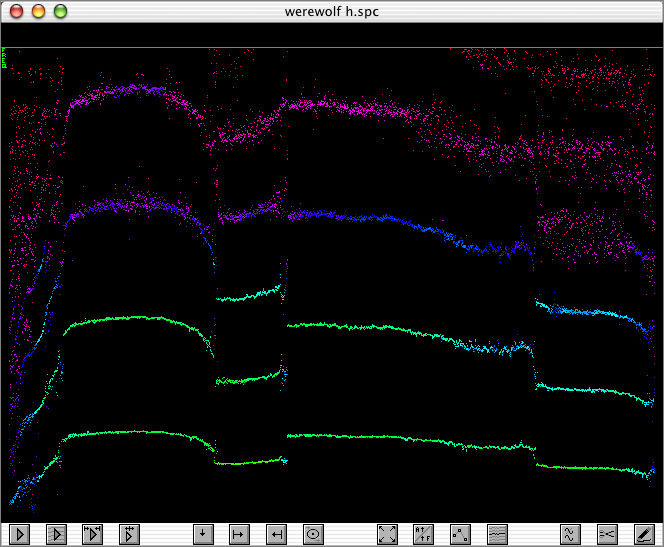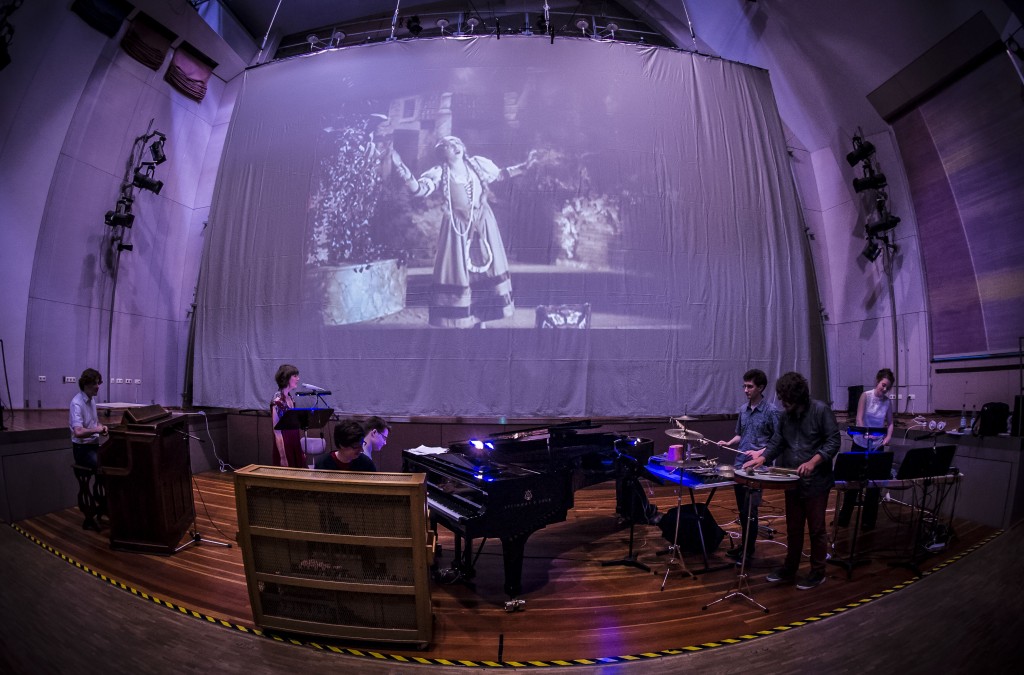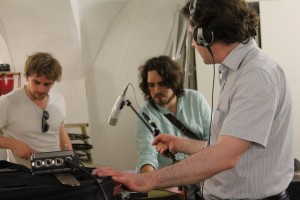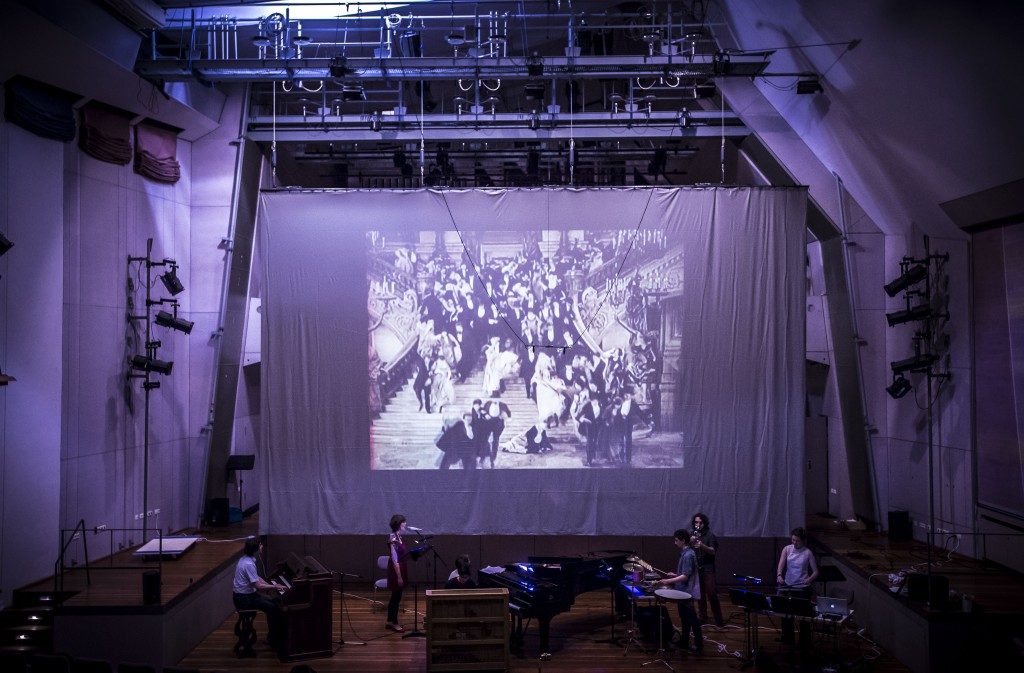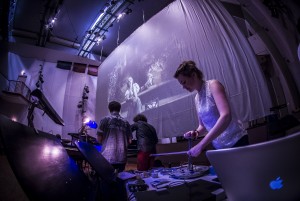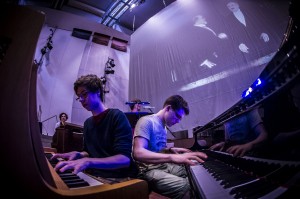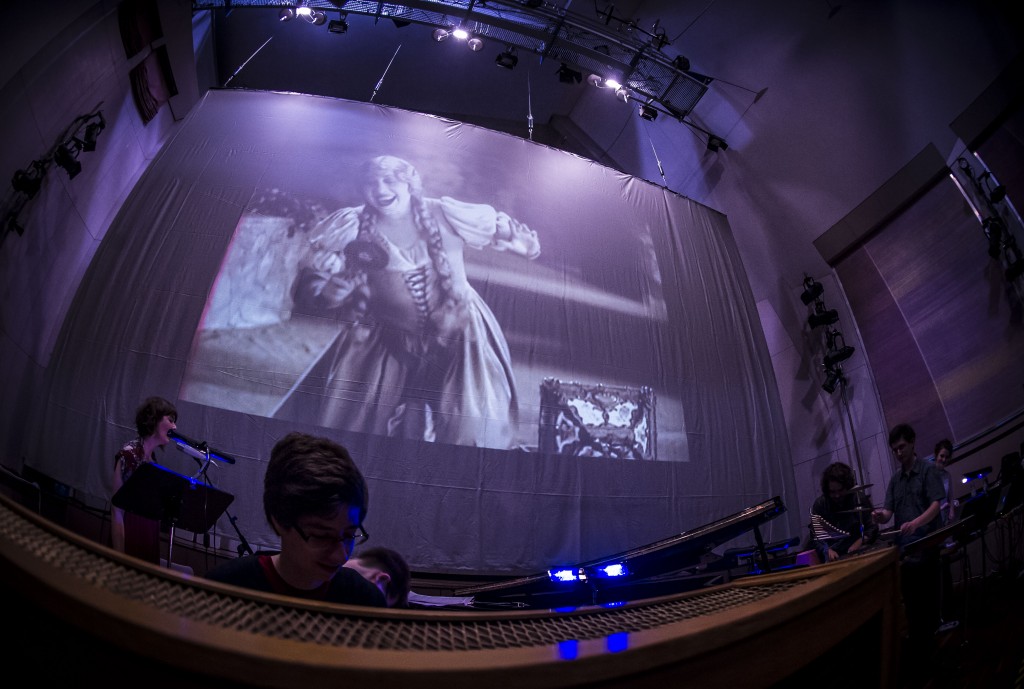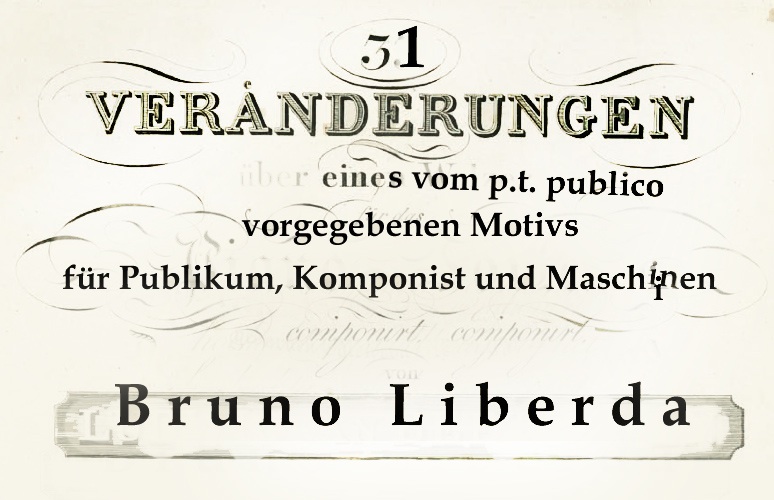Sound designer François Blaignan had an opportunity to apply Kyma in an unusual way in his work on the interactive multimedia exhibition Marvel’s Avengers STATION (Science Training and Tactical Intelligence Operative Network) now on display in Time Square in NYC and featured in this month’s Mix magazine. The 10,000-square-foot installation is a space where Avengers fans can immerse themselves in characters and artifacts associated with the Avengers.
 For the Tesseract Portal Device, the installation designers were having a hard time matching the look of the spectrograms of X-rays, infrared, and gamma rays provided to them by NASA.  So Blaignan created an animation using stills from Kyma’s spectrum editor and synched it to the Tessaract sound from the movie for a perfect match.
Kyma wasn’t a totally silent partner on the project; it also played a role in creating the sounds of the particle accelerator in Banner’s lab.
Category: Event
Kyma da gamba
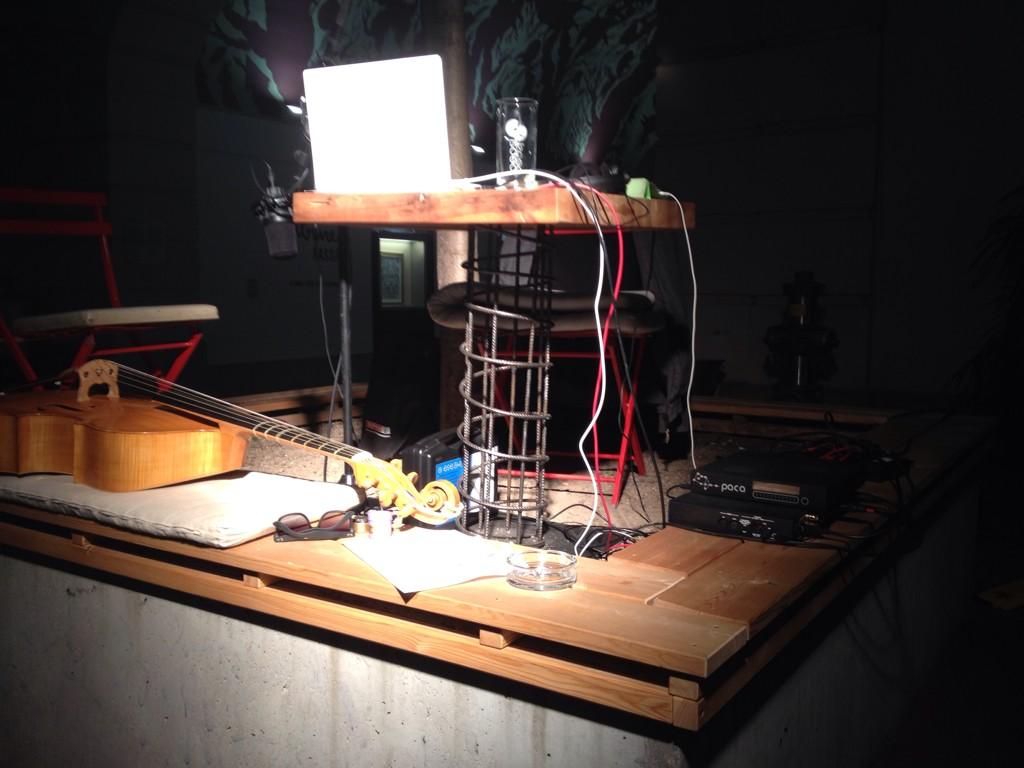 On 25 July 2014, Gustav Scholda performed a 45 minute live set at the Dschungel Cafe in Vienna’s Museums Quarter with Willibald Rosner (viola da gamba) and live spectral processing through Kyma. Gustav (aka kymaguy) described the result as “Tons of Overtones!”
On 25 July 2014, Gustav Scholda performed a 45 minute live set at the Dschungel Cafe in Vienna’s Museums Quarter with Willibald Rosner (viola da gamba) and live spectral processing through Kyma. Gustav (aka kymaguy) described the result as “Tons of Overtones!”Making people
In Garth Paine‘s new interactive Kyma work, CrossTalk, created in collaboration with Simon Biggs and Sue Hawksley, the text is automatically transcribed from the dancers’ speech as they describe inner body sensations and their relationship to the system. Later, the dancers collide with the sentences and the system generates a new language which they then dance, and so on. Watch as the printed sentences take the form of dancing stick figures projected on the back walls:
The creators describe it as an auto poetic system for making behaviors based on the anthropological idea of “making people†as described in their paper published in MOCO the Proceedings of International Workshop on Movement and Computing at IRCAM.
In July Garth presented an entire evening of his music (all composed and performed with Kyma) at the Skopja Summer Festival in Macedonia.
Moved by magnets
 SGR^CAV is a collaboration between composers Cristian Vogel and SØS Gunver Ryberg, exploring a phase space of possible musics, where phantasmagorical sound objects emerge from transient combinations of multi-dimensional parameters.
SGR^CAV is a collaboration between composers Cristian Vogel and SØS Gunver Ryberg, exploring a phase space of possible musics, where phantasmagorical sound objects emerge from transient combinations of multi-dimensional parameters.
 In January 2014 the duo SGR^CAV released their debut recording MOVED BY MAGNETSÂ on the cassette label Tapeworm.
In January 2014 the duo SGR^CAV released their debut recording MOVED BY MAGNETSÂ on the cassette label Tapeworm.
These works for cassette were composed from the precise arrangement of a number of elements—such as field recordings of coal  mining machinery in the arctic mountains, and the creaking of ancient trees in Denmark—combined with digital processing—such as self-similar additive synthesis and granulations—all developed in Kyma. Many of the other characteristic timbres were created using vintage studio technology. An awareness of the sonic qualities of the compact cassette medium was also an important factor in the composition.
Listening to the album feels like exploring a mysterious world with its own, alien yet self-consistent, laws of physics with faint echoes from the Columbia-Princeton Music Center of the 1960s.
From Organs to Organs — KISS2014: Organic Sound
Workshops, Talks, and Live Performances on “Organic Soundâ€
From organs (biological) to organs (musical), this year’s Kyma International Sound Symposium (KISS2014), to be held in Lübeck Germany on 25-28 September 2014, will explore multiple meanings of the phrase “organic sound†through technical talks, live performances, and hands-on workshops. Sound designers, composers, and live performers are invited to participate in a wide range of thought-provoking activities including:
- An examination of how to emulate the organic sound of the analog recording studio using Kyma, presented by composer/sound engineer Greg Hunter of Dub Sahara
- A special evening of “pipe organs like you’ve never heard them before†in the experimental, virtuosic hands of master organist/composer Franz Danksagmüller and his students
- Intensive afternoons in The Collaboratory creating and rehearsing several world premieres including a live sound track for a new film by experimental filmmaker Theo Lipfert performed by faculty and students of the Musikhochschule Lübeck processed through Kyma
- A hands-on “plantification” workshop where you’ll learn from Rudi Giot and his graduate engineering students how to control Kyma sounds through the growth of living plants
Events will kick off on Thursday with the unveiling of a major new release of the Kyma software and will culminate on Sunday with an evening of dancing to Kyma beats at club Parkhaus. The full program is online at: http://kiss2014.symbolicsound.com/detailed-program
About the Symposium
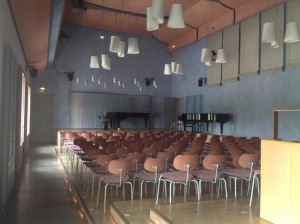 Hosted this year by Franz Danksagmüller and the Musikhochschule Lübeck, each morning of KISS2014: “Organic Sound” features technical/philosophical sessions on topics ranging from voice processing, to sonification of organic chemicals and the Internet, to organic growth and decay, to how to build your own performance controller and use it to control Kyma via OSC, to presentations by individual composer/performers detailing how they utilize Kyma in their live performances and installations.
Hosted this year by Franz Danksagmüller and the Musikhochschule Lübeck, each morning of KISS2014: “Organic Sound” features technical/philosophical sessions on topics ranging from voice processing, to sonification of organic chemicals and the Internet, to organic growth and decay, to how to build your own performance controller and use it to control Kyma via OSC, to presentations by individual composer/performers detailing how they utilize Kyma in their live performances and installations.
Afternoons are dedicated to interaction and hands-on activities including open rehearsals of collaborations-in-progress in The Collaboratory, a workshop on Conduction ensemble improvisation techniques presented by London Improvisers Orchestra trombonist and Kymaist Robert Jarvis, and the Kyma Open Lab where Kyma experts (Jeffrey Stolet, Cristian Vogel, Bruno Liberda, Scott Miller, Kurt Hebel, Carla Scaletti and others) will be on hand to answer your questions and consult with you on your current projects.
This year’s KISS features more live performances than ever before, with concerts every evening showcasing some of the best work created in Kyma this year, presented in the acoustically perfect MHL Große Saal and the Jakobikirche Lübeck with its three historically important pipe organs, famously decorated with faces on every pipe.
Check out the exciting lineup of presenters, composers, performers and Kyma experts here.
Who should attend
 Anyone who lives for sound — whether you are a novice looking to kickstart your career, an expert seeking a fresh jolt of inspiration, or simply someone who is curious about sound and Kyma — you will find in KISS2014 a chance to meet kindred spirits and immerse yourself in sound and ideas for four intense and inspiring days and nights of non-stop discussions, interactions, music and sound design.
Anyone who lives for sound — whether you are a novice looking to kickstart your career, an expert seeking a fresh jolt of inspiration, or simply someone who is curious about sound and Kyma — you will find in KISS2014 a chance to meet kindred spirits and immerse yourself in sound and ideas for four intense and inspiring days and nights of non-stop discussions, interactions, music and sound design.
Here’s how Chicago-based sound designer and re-recording mixer, Dustin Camilleri (http://www.pulsetrain.net) describes his experience at a previous KISS:
“…The unique thing about Kyma, I find, is that it appeals to such a wide spectrum of people doing such an amazingly diverse set of things, but sharing a common language. The conversations I had were so incredibly inspiring; the performances I saw were just over the top, and the community at large was just some of the nicest most genuine people I’ve ever had the pleasure of spending some time with.”
Registration and travel
Registration is now open: http://kiss2014.symbolicsound.com/kiss2014-registration. Discounts are available for students and for anyone registering before 1 August 2014.
For travel and lodging information, please visit:Â http://kiss2014.symbolicsound.com/travel-and-lodging
More information
Stay apprised of the latest KISS2014 news:
KISS2014 Site:Â http://kiss2014.symbolicsound.com
Facebook:Â https://www.facebook.com/pages/Kyma-International-Sound-Symposium/241910735840451
Twitter:Â http://twitter.com/KymaSymposium
Contact the organizers: mailto:info.kiss2014@gmail.com
Phantom of the opera
In celebration of Friday the thirteenth, Franz Danksagmüller and friends will perform a live sound track for the 1925 silent film The Phantom of the Opera in the Concert Hall of the Musikhochschule Lübeck (MHL).
Organ, harmonium, and soprano (all three processed through Kyma), piano, percussion, and the haunting sounds of the Gullyphone (Danksagmüller’s own invention, now complete with black light LEDs!) will all be contributing to the mysterious and dramatic live soundscape.
Friday the thirteenth of June 2014 at 8 pm in Lübeck at the MHL Großer Saal.
Scott Miller named Fulbright Scholar
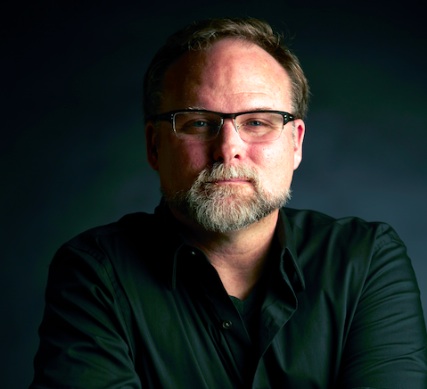 Composer and Kyma enthusiast, Scott L. Miller, has been awarded a Fulbright Scholar grant to lecture at the Academy of Music and Theatre in Estonia during the 2014-2015 academic year. Professor Miller will lecture on approaches to electroacoustic composition, with an emphasis on real-time electronics and improvisation with Kyma.
Composer and Kyma enthusiast, Scott L. Miller, has been awarded a Fulbright Scholar grant to lecture at the Academy of Music and Theatre in Estonia during the 2014-2015 academic year. Professor Miller will lecture on approaches to electroacoustic composition, with an emphasis on real-time electronics and improvisation with Kyma.
Miller’s Every Problem is a Nail, for piano and electronics, premiers on June 7 at the New York City Electronic Music Festival (NYCEMF). The piece will be performed by pianist Keith Kirchoff (who commissioned the work), and was supported in part by the American Composers Forum 2013 McKnight Composer Fellowship Program.
Also on the NYCEMF will be the NYC premier of Miller’s Contents May Differ, performed by bass clarinetist Pat O’Keefe on June 4. O’Keefe commissioned the piece and his recording of the work is to be released on Innova later this year.  Both Every Problem is a Nail and Contents May Differ feature the Additive Synthesis Sound that Miller created especially for teaching his students.
The world premiere of Miller’s Electro-organic Ecosystem for pipe organ and Kyma is set for 26 September 2014 as part of the Kyma International Sound Symposium (KISS2014) in Lübeck Germany 25-29 September.
Publikum, Komponist und Kyma
In 1819, Diabelli provided a waltz theme and asked all the major composers of Vienna to compose a variation on the theme so he could compile all of them into a single Theme and Variations.  Beethoven indignantly refused to write a variation on such a “Schusterfleck” of a theme, and then, in irritation decided to show what you could do with such a banal and not very charming subject by composing, not one, but 33 variations with a playing time of over 50 minutes; he even demonstrated his own brand of humor in that Variation No. 22 is not a real variation but a quote from Don Giovanni (“Hab kein Ruh bei Tag und Nacht“).
Now in 2014, Viennese composer Bruno Liberda, intrigued with this idea of finding such a wealth of material within a simple source, proposes to create 31 variations on a theme provided by the audience! Â All those who are present will witness the composition of a new piece.
Audience members will improvise sounds using brooms, scissors, paper, piano, wire, bell, cellophane, porcelain and other instruments which will be distilled by the composer over the course of the performance into motifs that become 31 overlapping variations.
Witness a new piece in the process of formation! Boundaries cancel… between emergence and the finished work, between a composer and an audience, between show and do.
See, hear, and experience together the process of composition!
Wo: Alte Schmiede, Schönlaterngasse 9, 1010 Wien Wann: 30 April 2014, 19hThe Collaboratory

What if you could hear your music performed on a 500 year old organ that was once played by J.S. Bach? What if you could invent a new kind of live DJ set with Kyma and live percussion? Or work with an opera singer and a pop singer to develop new ways of transforming the voice in a live performance? What if you could spend several days experimenting with live Kyma-processing of strings, woodwinds, piano, percussion, and other acoustic instruments?
The Collaboratory is a “collaboration laboratory” where you can be part of a team of composers/performers/technologists inventing a new kind of live performance piece, live improvisation, live sound-track-to-picture performance, live DJ set or experimental live interaction involving Kyma and acoustic or electronic performers. The choices are yours, and the possibilities are limitless. Make a proposal and see what happens!
The Voice of Pi
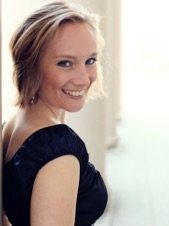 Composer Franz Danksagmüller and soprano Berit Barfred Jensen will be in Copenhagen for the February 19th premiere of Danksagmüller’s new composition for voice and Kyma: sound of pi: flow my tears (for voice and continuo).
Composer Franz Danksagmüller and soprano Berit Barfred Jensen will be in Copenhagen for the February 19th premiere of Danksagmüller’s new composition for voice and Kyma: sound of pi: flow my tears (for voice and continuo).
Danksagmüller will be performing the basso continuo part on a Continuum Fingerboard controlling Kyma sounds tuned to a special scale based on pi. Background textures will be granulated voices derived from the live solo voice.
It will be the first piece on Berit Barfred Jensen‘s solo voice recital at the Old Radio Hall at the Royal Danish Conservatoire in Copenhagen with the Holmes’s Baroque Ensemble and Søren Rastogi (piano). Music by Handel, Schubert, Grieg, Margarete Schweikert and Franz Danksagmüller.
 Date: Wednesday 19 February 2014Â
Time: at. 7:30 p.m. to 9:30 p.m.
Date: Wednesday 19 February 2014Â
Time: at. 7:30 p.m. to 9:30 p.m.Location: Conservatory Koncertsal, Julius Thomsen Gade 1
Admission: Free admission
Â
